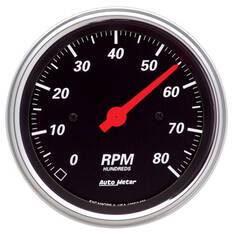Expert Tips for Keeping and Calibrating Your Tachometer
Expert Tips for Keeping and Calibrating Your Tachometer
Blog Article
Discovering the Functions and Benefits of a Tachometer: A Comprehensive Overview for Vehicle Lovers
From supplying real-time data on engine speed to assisting in maximizing equipment shifts, the tachometer serves as even more than just a dial on the dashboard. Its complex features not just enhance driving experience but likewise play a pivotal duty in preserving engine health and performance.
Comprehending the Essentials of a Tachometer
In the world of auto instrumentation, recognizing the essentials of a tachometer is essential for any vehicle fanatic looking to delve into the details of engine performance surveillance. A tachometer, frequently shown on the control panel of a vehicle, gauges the engine's revolutions per minute (RPM)
Tachometers commonly have a scale noted in changes per minute, with a redline suggesting the optimum rate at which the engine can safely operate (tachometer). This info is essential for stopping engine damages and maximizing equipment shifting for manual transmissions. Furthermore, tachometers can help in detecting engine concerns such as misfires or a falling short ignition system by discovering uneven RPM analyses
Value of Monitoring Engine Speed

Keeping an eye on engine speed is a crucial facet of lorry upkeep and performance optimization for auto lovers and experts alike. The engine rate, measured in revolutions per min (RPM), suggests how quickly the engine's crankshaft is revolving. By maintaining a close eye on the RPM, motorists can guarantee that the engine is running within the ideal range, protecting against possible damages from over-revving or stalling. Checking engine speed is specifically important throughout gear changes, as it helps vehicle drivers identify the correct time to alter gears for smooth velocity and efficient gas consumption.
In addition, tracking engine rate can also supply valuable insights right into the overall health and wellness of the lorry. Unusual changes in RPM might show issues such as a clogged up air filter, fuel system issues, and even engine misfires. By detecting these irregularities early with the tachometer analyses, drivers can address prospective problems immediately, preventing more severe damage and expensive repair services down the line. On the whole, monitoring engine rate with a tachometer is a basic practice that can enhance driving performance, prolong engine life, and ensure a safer and extra enjoyable driving experience.
Enhancing Performance Through Equipment Shifts
Correct equipment changing makes certain that the engine operates within its ideal power band, allowing for smooth velocity and boosted gas economic climate. When shifting equipments, it is essential to pay focus to the engine speed suggested on the tachometer.

To attain peak performance through gear read this changes, drivers should exercise smooth and prompt transitions between gears, matching engine speed with road rate to harness the full capacity of their automobile's powertrain.
Making The Most Of Effectiveness With a Tachometer
Grasping the art of equipment moving in high-performance vehicles not only enhances driving experience but likewise plays a vital duty in making best use of efficiency with a tachometer. tachometer. By paying close focus to the tachometer analyses, vehicle drivers can maximize their equipment changes to operate within the engine's most effective array. When increasing, changing equipments at the ideal RPM suggested by the tachometer can avoid the engine from exhausting or underperforming, causing boosted gas effectiveness and overall performance
Additionally, a tachometer aids drivers avoid unneeded revving, which not just loses gas however likewise puts unnecessary pressure on the engine. Continually checking the tachometer while driving permits smoother gear shifts, decreasing wear and tear on the transmission system over time.

Advanced Tips for Tachometer Usage
To dive right into innovative ideas for tachometer use, take into consideration including the usage of change lights. Shift lights are visual indicators that brighten when it's time to change gears based on engine transformations per minute (RPM), allowing for smooth equipment modifications without continuously keeping an eye on the tachometer. By fine-tuning shift points and setting warning limits, motorists can enhance acceleration and engine efficiency while reducing the risk of over-revving.
Conclusion
In official source verdict, the tachometer functions as a vital tool for vehicle fanatics to check engine rate, enhance efficiency with gear changes, and maximize effectiveness. By comprehending the features and benefits of a tachometer, drivers can maximize their driving experience and prolong the life-span of their automobile. Making use of sophisticated tips for tachometer use can even more boost driving skills important source and total performance when traveling.
Report this page